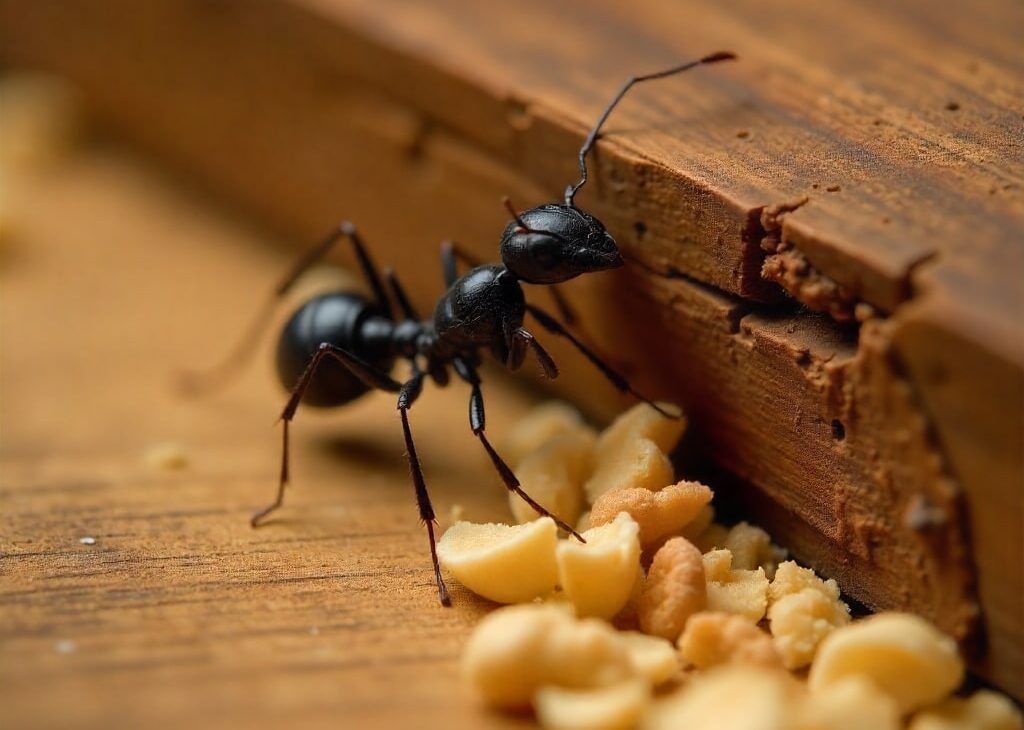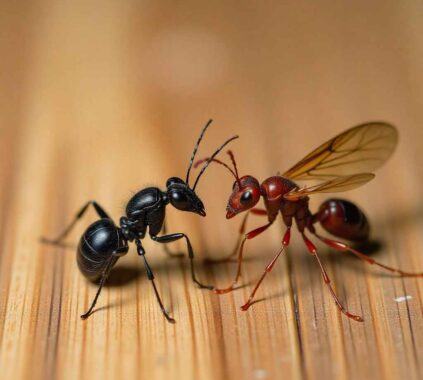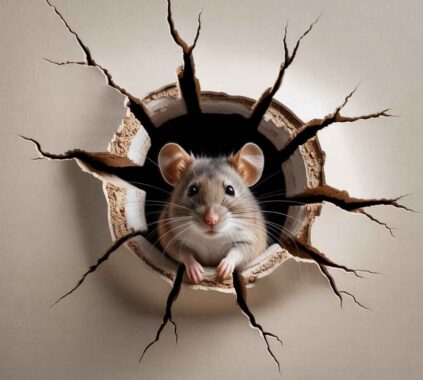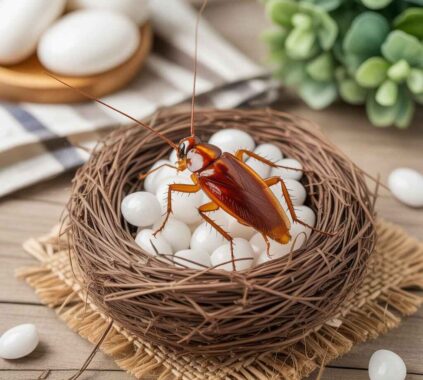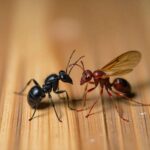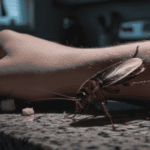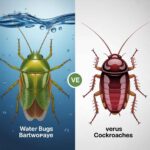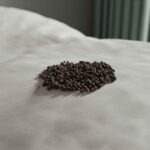Table of Contents
When you notice mysterious piles of what looks like sawdust near wooden structures in your home, there’s a good chance you’re dealing with carpenter ant frass. Many homeowners mistake this for harmless dust, but it’s one of the most visible signs of a carpenter ant infestation. Understanding what frass is, why it appears, and how to eliminate it effectively can save you from serious structural damage.
This detailed guide explains what carpenter ant frass looks like, how to distinguish it from termite droppings, and the most reliable ways to eliminate carpenter ants before they cause long-term harm.
What Is Carpenter Ant Frass?
Carpenter ant frass is a mix of finely shredded wood particles, insect parts, and droppings that form as carpenter ants excavate tunnels inside wood to build their nests. Unlike termites, carpenter ants don’t eat the wood; they simply remove it to create living space for the colony.
These ants push the debris out of small openings known as kick-out holes, leaving tiny piles beneath beams, door frames, or baseboards. If you find frass indoors, it’s a strong sign that ants are tunneling nearby.
Carpenter Ant Frass vs Termite Frass
Many homeowners confuse carpenter ant frass vs termite frass, but there are easy ways to tell the difference.
- Texture: Carpenter ant frass looks like irregular wood shavings or sawdust. Termite frass consists of small, uniform pellets.
- Location: Termite droppings often sit directly below damaged wood. Carpenter ant frass may collect near baseboards, window frames, or ceilings.
- Composition: Carpenter ant frass includes bits of insulation, dirt, and insect fragments, while termite frass is entirely fecal matter.
If you find something resembling pencil shavings beneath wood, it’s probably carpenter ant frass.
Common Places to Find Carpenter Ant Frass in the House
Carpenter ant frass in house settings can appear anywhere wood meets moisture. Typical hiding spots include:
- Beneath window sills and door frames
- Near baseboards, floor joists, or trim
- Inside attics, crawl spaces, and basements
- Around kitchens and bathrooms, where humidity is high
- Behind drywall, wall studs, and wooden beams
Carpenter ants thrive in damp or decaying wood. A leaky pipe, clogged gutter, or poorly ventilated room often provides the ideal environment.
Signs of Carpenter Ant Damage
Spotting carpenter ant isn’t the only indicator of trouble. Look for:
- Rustling sounds coming from the walls or ceilings
- Winged ants swarming around lights or vents
- Soft, hollow wood when tapped
- Tiny holes where ants eject debris
- Visible ant trails near moisture sources
A growing colony can create satellite nests throughout your home. Catching the problem early prevents major carpenter ant damage later.
Carpenter Ant Frass Bite: Should You Worry?
A carpenter ant frass bite isn’t something to panic about. These ants can bite when threatened, and although their bite isn’t venomous, it may sting slightly because of formic acid. The real risk lies in the wood damage they cause over time.
If you’re noticing both ants and frass together, it’s time for immediate action.
How to Get Rid of Carpenter Ants
Eliminating carpenter ant starts with removing the ants that create it. Follow this step-by-step process:
Step 1: Identify the Nest
Trace the frass back to its source. Tap wooden areas and listen for hollow sounds or faint rustling. These clues often reveal the main nest.
Step 2: Clean the Area
Vacuum all visible frass. This clears debris and allows you to monitor if new piles appear, confirming an active nest.
Step 3: Apply a Carpenter Ant Killer
Use a carpenter ant killer or powdered insecticide directly inside visible openings. Boric acid and diatomaceous earth are safe and effective options.
Step 4: Use Carpenter Ant Bait
Strategically place carpenter ant bait near active trails. The worker ants carry it back to the colony, wiping out the entire population gradually.
Step 5: Seal Entry Points
Seal cracks, vents, and crevices where ants may enter. Pay special attention to plumbing and wiring penetrations.
Step 6: Replace Damaged Wood
Remove any rotted or moisture-softened wood. Treat new wood with a protective sealant to deter future infestations.
Step 7: Call Professional Help
For persistent infestations or hidden nests, professional pest control experts can locate and treat colonies behind walls and ceilings.
Carpenter Ant Frass Killer: DIY or Professional?
DIY solutions such as boric acid, ant baits, and insecticide dust work for minor infestations. However, large or recurring problems require professional treatment. Experts use advanced detection tools to locate hidden nests and moisture sources that attract carpenter ants in the first place.
Professional treatments also provide long-term warranties and prevention advice, saving money and stress over time.
Carpenter Ant Frass Reddit Experiences
Discussions on carpenter ant frass Reddit threads show that many homeowners initially mistake frass for sawdust. Common stories include finding recurring piles after cleaning or hearing soft crackling noises inside the walls. These real-world experiences highlight the importance of investigating frass immediately rather than ignoring it.
Preventing Future Carpenter Ant Infestations
Once you’ve removed carpenter ant frass, prevention becomes your best defense. Here’s how to keep these destructive pests away:
- Repair leaks in roofs, gutters, and plumbing right away.
- Store firewood at least 20 feet from your home.
- Trim trees and shrubs so they don’t touch your walls or roof.
- Seal wall gaps and foundation cracks.
- Ventilate attics and basements to control moisture.
- Schedule regular pest inspections annually.
Small maintenance steps now can prevent thousands of dollars in repairs later.
The Importance of Acting Fast
Ignoring carpenter ant allows the colony to grow, eventually spreading through beams, flooring, and walls. These ants don’t eat wood like termites, but the constant tunneling weakens structures. Swift action stops the damage before it becomes expensive.
Think of frass as a message from inside your walls: something is wrong. Cleaning alone isn’t enough—investigate, locate the source, and take decisive steps to eliminate the nest.
FAQs About Carpenter Ant Frass
1. Is ant frass toxic?
No, carpenter ant frass is not toxic, but it signals that ants are nesting inside your wood and causing structural damage.
2. Are carpenter ants frass or termites?
Carpenter ant frass comes from ants, not termites. Termites eat wood, while carpenter ants remove it to build tunnels.
3. Does frass mean an infestation?
Yes, finding carpenter ant frass usually means there’s an active infestation nearby that needs immediate attention.
4. What is ant frass in the house?
Carpenter ant frass in the house looks like sawdust or tiny wood shavings under walls, windows, or baseboards, showing ants are burrowing inside.
5. What is the fastest way to get rid of carpenter ants?
The quickest way to remove carpenter ant frass and ants is to locate the nest, use bait or boric acid, and seal all entry points.
6. Is termite frass toxic?
No, like carpenter ant frass, termite frass isn’t toxic, but both indicate serious pest activity that requires professional treatment.
Final Thoughts
Carpenter ant frass is more than just a nuisance—it’s an early warning sign that your home may be under attack. By learning what it looks like, where to find it, and how to eliminate the source, you can protect your property from escalating damage.
Whether you choose a DIY approach or hire professionals, act promptly. Prevention and timely treatment are the keys to keeping your home safe from carpenter ant damage and future infestations.

